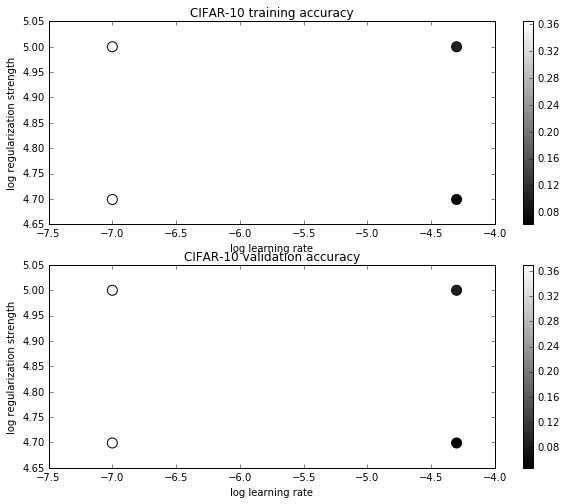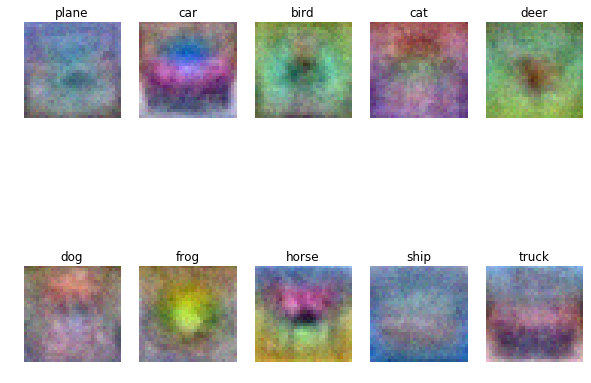斯坦福CS231n 課程學習筆記--線性分類器(Assignment1程式碼實現)
阿新 • • 發佈:2019-01-01
最近學習了斯坦福的CS231n(winter 2016)系列課程,收穫很大,作為深度學習以及卷積神經網路學習的入門很是完美。學習過程中,主要參考了知乎上幾位同學的課程翻譯,做得很好,在這裡也對他們表示感謝,跟課程相關的很多資源都可以在該專欄中找到。推薦大家把每個筆記的翻譯都完整的看一下。關於該課程視訊的中文字幕也在翻譯進行中,目前第一集已經翻譯完成,感興趣的同學可以也可以看看參與進去。此外,完成課程視訊和筆記的閱讀之後也對課程的3個Assignment進行了實現。接下來主要以對課程筆記總結和Assignment程式碼實現相結合的方式完成這一系列的部落格。
本篇部落格主要對Assignment1
這裡我直接貼出自己的程式碼,相關注釋已經下載檔案之中:
1,linear_svm.py
import numpy as np
def svm_loss_naive(W, X, y, reg):
dW = np.zeros(W.shape) # initialize the gradient as zero 2,softmax.py
import numpy as np
#原理和svm一樣。也分為兩種計算方法。
def softmax_loss_naive(W, X, y, reg):
# Initialize the loss and gradient to zero.
loss = 0.0
dW = np.zeros_like(W) # D by C
dW_each = np.zeros_like(W)
num_train, dim = X.shape
num_class = W.shape[1]
f = X.dot(W) # N by C
# Considering the Numeric Stability
#考慮數值穩定性。減去f分值中最大的項。見上篇部落格
f_max = np.reshape(np.max(f, axis=1), (num_train, 1)) # N by 1
#計算歸一化概率
prob = np.exp(f - f_max) / np.sum(np.exp(f - f_max), axis=1, keepdims=True) # N by C
y_trueClass = np.zeros_like(prob)
y_trueClass[np.arange(num_train), y] = 1.0
for i in xrange(num_train):
for j in xrange(num_class):
loss += -(y_trueClass[i, j] * np.log(prob[i, j]))
dW_each[:, j] = -(y_trueClass[i, j] - prob[i, j]) * X[i, :]
dW += dW_each
loss /= num_train
loss += 0.5 * reg * np.sum(W * W)
dW /= num_train
dW += reg * W
return loss, dW
def softmax_loss_vectorized(W, X, y, reg):
# Initialize the loss and gradient to zero.
loss = 0.0
dW = np.zeros_like(W) # D by C
num_train, dim = X.shape
f = X.dot(W) # N by C
# Considering the Numeric Stability
f_max = np.reshape(np.max(f, axis=1), (num_train, 1)) # N by 1
prob = np.exp(f - f_max) / np.sum(np.exp(f - f_max), axis=1, keepdims=True)
y_trueClass = np.zeros_like(prob)
y_trueClass[range(num_train), y] = 1.0 # N by C
loss += -np.sum(y_trueClass * np.log(prob)) / num_train + 0.5 * reg * np.sum(W * W)
dW += -np.dot(X.T, y_trueClass - prob) / num_train + reg * W
return loss, dW3,linear_classifier.py
from linear_svm import *
from softmax import *
class LinearClassifier(object):
def __init__(self):
self.W = None
def train(self, X, y, learning_rate=1e-3, reg=1e-5, num_iters=100, batch_size=200, verbose=True):
num_train, dim = X.shape
# assume y takes values 0...K-1 where K is number of classes
num_classes = np.max(y) + 1
if self.W is None:
# lazily initialize W
self.W = 0.001 * np.random.randn(dim, num_classes) # D by C
# Run stochastic gradient descent(Mini-Batch) to optimize W
loss_history = []
for it in xrange(num_iters):
X_batch = None
y_batch = None
# Sampling with replacement is faster than sampling without replacement.
sample_index = np.random.choice(num_train, batch_size, replace=False)
X_batch = X[sample_index, :] # batch_size by D
y_batch = y[sample_index] # 1 by batch_size
# evaluate loss and gradient
loss, grad = self.loss(X_batch, y_batch, reg)
loss_history.append(loss)
# perform parameter update
self.W += -learning_rate * grad
if verbose and it % 100 == 0:
print 'Iteration %d / %d: loss %f' % (it, num_iters, loss)
return loss_history
def predict(self, X):
y_pred = np.zeros(X.shape[1]) # 1 by N
y_pred = np.argmax(np.dot(self.W.T, X.T), axis=0)
return y_pred
def loss(self, X_batch, y_batch, reg):
pass
class LinearSVM(LinearClassifier):
""" A subclass that uses the Multiclass SVM loss function """
def loss(self, X_batch, y_batch, reg):
return svm_loss_vectorized(self.W, X_batch, y_batch, reg)
class Softmax(LinearClassifier):
""" A subclass that uses the Softmax + Cross-entropy loss function """
def loss(self, X_batch, y_batch, reg):
return softmax_loss_vectorized(self.W, X_batch, y_batch, reg)notebook上面的程式碼,其實主要是實現超引數調優的功能。
# softmax.ipynb
from cs231n.classifiers import Softmax
results = {}
best_val = -1
best_softmax = None
learning_rates = [5e-6, 1e-7, 5e-7]
regularization_strengths = [1e4, 5e4, 1e5]
params = [(x,y) for x in learning_rates for y in regularization_strengths ]
for lrate, regular in params:
softmax = Softmax()
loss_hist = softmax.train(X_train, y_train, learning_rate=lrate, reg=regular,
num_iters=700, verbose=True)
y_train_pred = softmax.predict(X_train)
accuracy_train = np.mean( y_train == y_train_pred)
y_val_pred = softmax.predict(X_val)
accuracy_val = np.mean(y_val == y_val_pred)
results[(lrate, regular)] = (accuracy_train, accuracy_val)
if(best_val < accuracy_val):
best_val = accuracy_val
best_softmax = softmax
# Print out results.
for lr, reg in sorted(results):
train_accuracy, val_accuracy = results[(lr, reg)]
print 'lr %e reg %e train accuracy: %f val accuracy: %f' % (
lr, reg, train_accuracy, val_accuracy)
print 'best validation accuracy achieved during cross-validation: %f' % best_val
# svm.ipynb
from cs231n.classifiers import LinearSVM
learning_rates = [1e-7, 5e-5]
regularization_strengths = [5e4, 1e5]
results = {}
best_val = -1 # The highest validation accuracy that we have seen so far.
best_svm = None # The LinearSVM object that achieved the highest validation rate.
iters= 1000
for lr in learning_rates:
for rs in regularization_strengths:
svm = LinearSVM()
svm.train(X_train, y_train, learning_rate=lr, reg=rs, num_iters=iters)
y_train_pred = svm.predict(X_train)
acc_train = np.mean(y_train == y_train_pred)
y_val_pred = svm.predict(X_val)
acc_val = np.mean(y_val == y_val_pred)
results[(lr, rs)] = (acc_train, acc_val)
if best_val < acc_val:
best_val = acc_val
best_svm = svm
# Print out results.
for lr, reg in sorted(results):
train_accuracy, val_accuracy = results[(lr, reg)]
print 'lr %e reg %e train accuracy: %f val accuracy: %f' % (
lr, reg, train_accuracy, val_accuracy)
print 'best validation accuracy achieved during cross-validation: %f' % best_val貼上幾張執行過程中的截圖:



